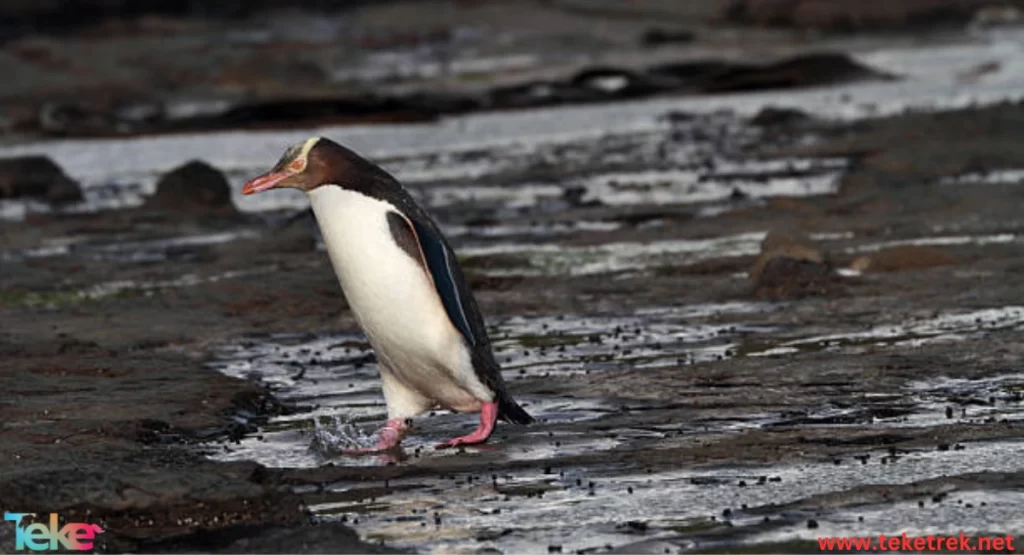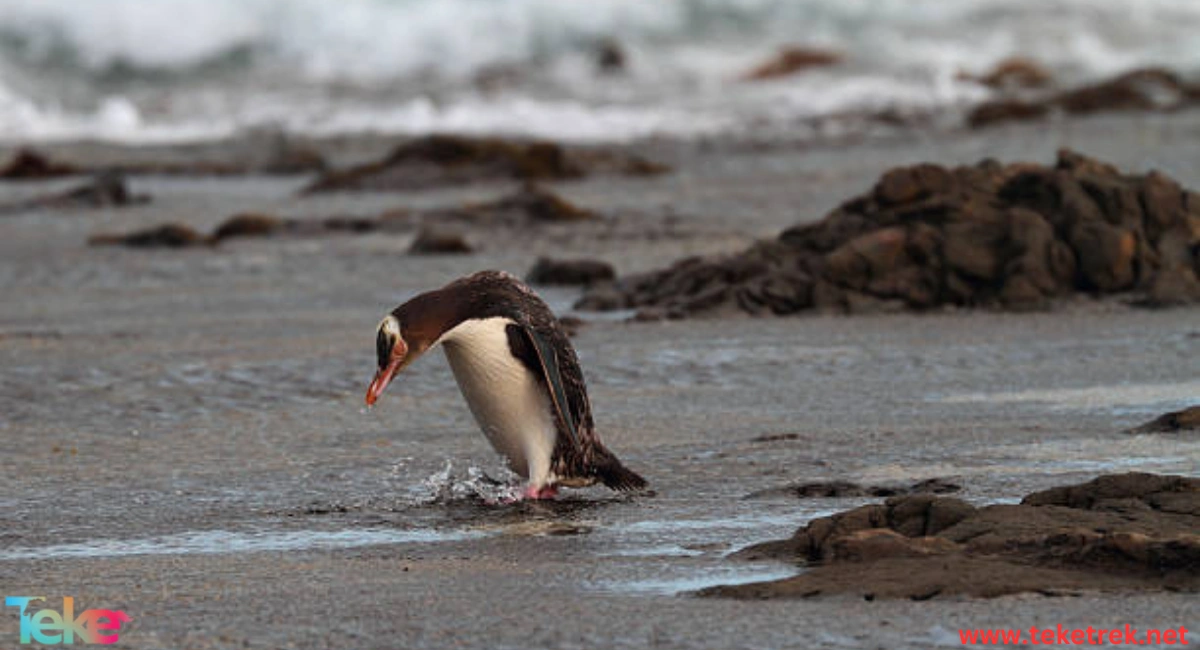There are various species of penguins that inhabit our planet, including the Yellow-eyed Penguin, which is distinguished by the color of its eyes. This penguin also has a unique lifestyle.
To learn more about this bird, continue reading the following article on TekeTrek .

Yellow-eyed penguin description
- The yellow-eyed penguin belongs to the genus Megadyptes, They are also known as Hoiho or Maori Penguins and belong to the penguin family.
- The Yellow-eyed Penguin belongs to the class Aves, within the phylum Chordata.
- The Yellow-eyed Penguin is a tall and slender bird, reaching a Yellow eyed penguin height of 60 cm and weighing between 5 and 8 kilograms. As its name suggests, its main feature is its yellow eyes.
- The body of the Yellow-eyed Penguin is predominantly white and black, except for the yellow feathered crest surrounding its head.
- Male and female Yellow-eyed Penguins appear relatively similar, but males have broader heads and feet than females.
- Juvenile Yellow-eyed Penguins have grey eyes and dark brown or grey feathers, lacking the vibrant yellow feathered crest seen in adults.
Yellow-eyed penguin habitat
Yellow-eyed Penguins can be found on Campbell Island, Auckland Island, Stewart Island, the South Island of New Zealand, and the Otago Peninsula. They are marine birds that dive into the water to hunt for prey.
Yellow-eyed penguin diet
The yellow-eyed penguin is a carnivorous bird, and feeds on fish and squid, especially red and blue cod, in addition to kingfish and oysters, as well as opal, chain, and ahuru fish.
What is the behavior of the yellow-eyed penguin?
These penguins are sedentary, and do not undertake migratory journeys. They are also not as social as other species, so they do not congregate in crowded colonies, preferring to walk long distances on their own and dip into the sea individually.
The Reproduction Stages of the Yellow-eyed Penguin
- The courtship season for Yellow-eyed Penguins typically begins around May, with the breeding season occurring in August, including partner selection and nest sites. Yellow-eyed penguins are not found in colonies. They create individual nests in New Zealand’s forests and do not gather with other individuals.
- These penguins prefer secluded spots typically supported by a tree and do not nest within sight of other birds.
- Yellow-eyed Penguins only come together during courtship and mating rituals. After choosing a partner, they form long-term pairs, only separating if one is infertile or dies.
- The female Yellow-eyed Penguin lays eggs after 12 days of incubation, which are then incubated for 39 to 51 days before hatching.
- During the first six weeks after hatching, both parents closely guard their chicks, taking turns diving daily to feed them.
- Once the chicks reach six weeks of age, both parents abandon them for foraging. The chicks usually remain in the nest until mid-February.
- Yellow-eyed Penguins reach sexual maturity after 2 to 3 years for females and 3 to 5 years for males, with an average lifespan of 23 years.
Yellow eyed penguin facts
Here are some notable facts about the Yellow-eyed Penguin:
- Yellow-eyed Penguins are the fourth tallest penguin species.
- They are considered one of the rarest penguin species in the world.
- Yellow-eyed Penguins may be one of the oldest penguin species still in existence.
- In the spring of 2004, Yellow-eyed Penguins faced a significant threat when a bacterial disease killed 60% of the chicks in the Otago Peninsula of New Zealand.
- These birds are endangered due to habitat loss, predators, ocean pollution, and depletion of food sources caused by overfishing. They often feel disturbed by humans and livestock when they are within their coastal range.
FAQ
Here are some of the most common questions about the Yellow-eyed Penguin:
- How long do Yellow-eyed Penguins live?
The average lifespan of Yellow-eyed Penguins is around 8 years, although they can live up to 25 years in the wild.
- Are Yellow-eyed Penguins carnivorous?
Yes, Yellow-eyed Penguins primarily feed on fish.
- Are yellow-eyed penguins rare?
Yes, Yellow-eyed Penguin is rare.
- How many yellow-eyed penguins are left?
As of recent estimates, there are roughly around 4,000 to 5,000 Yellow-eyed Penguins left in the wild, making them an endangered species.
- What is special about the yellow-eyed penguin?
The Yellow-eyed Penguin is special because of its striking yellow eyes, endangered status, unique solitary nesting behavior, and conservation importance for biodiversity.


In conclusion
In conclusion, the Yellow-eyed Penguin is a fascinating creature that captivates attention with its enchanting eyes and unique beauty among penguin species. These birds face environmental challenges due to habitat loss and human activities affecting their environment. Therefore, it’s important to emphasize the importance of protecting their natural habitats and working to reduce human impacts on them.
Through ongoing conservation efforts, we can preserve these remarkable creatures and ensure their survival for future generations. The Yellow-eyed Penguin is an essential part of biodiversity and the beauty of nature, and it’s crucial for us to join forces to protect and conserve them in their original natural habitat.






